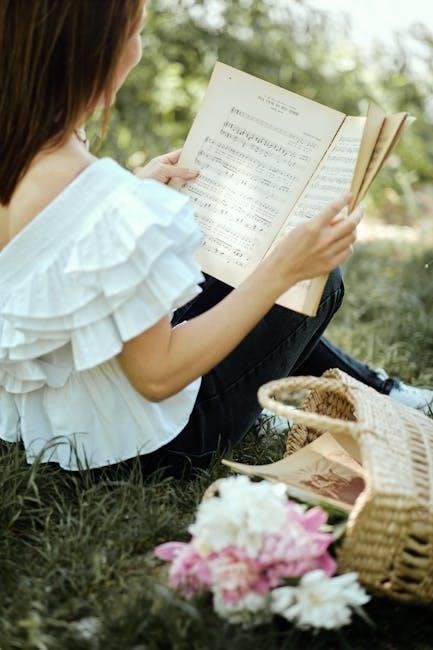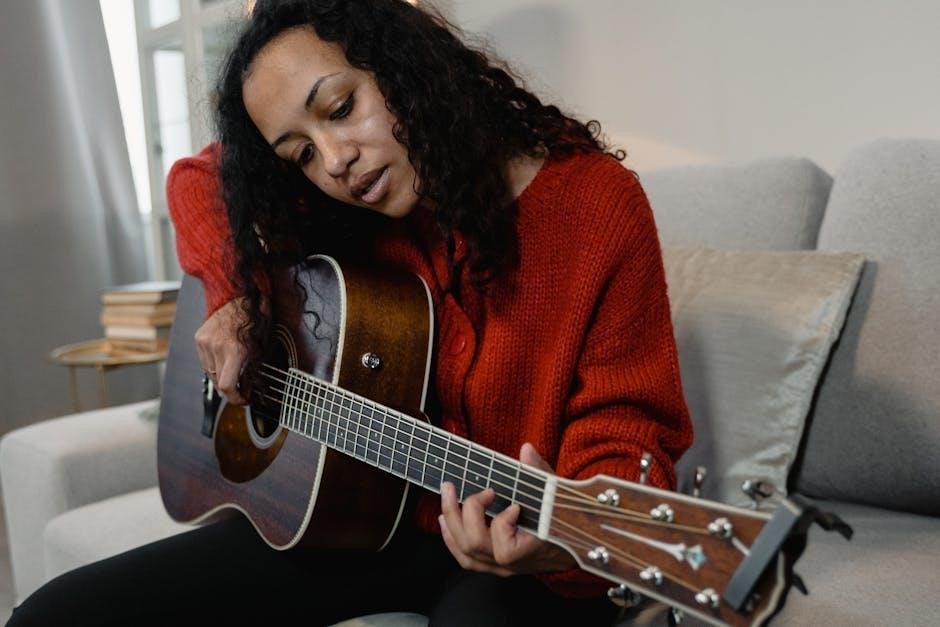“Maybe This Time” from the iconic musical Cabaret is a powerful ballad capturing hope and longing. Composed by John Kander with lyrics by Fred Ebb, the sheet music offers a rich arrangement for piano, vocal, and guitar, making it a versatile choice for performers. Available in A Major, this 6-page PDF is a must-have for musicians seeking to bring emotional depth to their repertoire.
1.1 Overview of the Song
“Maybe This Time” is a poignant ballad from the musical Cabaret, expressing hope and longing in a romantic relationship. Composed by John Kander with lyrics by Fred Ebb, the song has become a timeless classic. Its emotional depth resonates with audiences, making it a popular choice for performers. The sheet music, available in A Major, features arrangements for piano, vocal, and guitar, offering versatility for musicians. With 6 pages of detailed notation, it provides a comprehensive guide for both beginners and seasoned artists. The song’s theme of optimism and vulnerability continues to captivate, ensuring its enduring appeal in musical theatre and beyond.
1.2 Importance of Sheet Music in Musical Performance
Sheet music is a foundational tool for musicians, providing precise notes, rhythms, and harmonies. For “Maybe This Time,” it ensures accuracy and consistency in performance, preserving the song’s emotional intent. The PDF and MIDI formats allow for easy access and adaptability across instruments like piano and guitar. Sheet music enables performers to master complex melodies and lyrics, essential for delivering a compelling interpretation. It also serves as a universal language, uniting musicians in shared performances. With “Maybe This Time,” the sheet music’s clarity and detail are vital for capturing the song’s poignant message, making it indispensable for both practice and live renditions.
The Song “Maybe This Time” from the Musical Cabaret
“Maybe This Time” is a poignant ballad from the musical Cabaret, composed by John Kander with lyrics by Fred Ebb. It captures themes of hope and longing, resonating deeply with audiences through its emotional depth and powerful melody. The song’s availability in PDF and MIDI formats makes it accessible for musicians to perform and interpret, ensuring its enduring presence in musical performances.
2.1 Background and Context of the Musical Cabaret
The musical Cabaret is set in 1930s Berlin, created by John Kander and Fred Ebb, based on John Van Druten’s play I Am a Camera and adapted from Christopher Isherwood’s semi-autobiographical novel. It explores themes of love, politics, and social change, set against the backdrop of the city’s vibrant nightlife and the rise of the Nazi Party. The musical is known for its bold and decadent style, featuring songs that reflect the era’s moral ambiguity and cultural shifts. Cabaret’s narrative is presented within the fictional Kit Kat Klub, blending entertainment with deeper societal commentary. Its music plays a central role in storytelling and emotional impact, making it a timeless classic.
2.2 The Role of “Maybe This Time” in the Musical
“Maybe This Time” is a poignant ballad sung by Sally Bowles in Cabaret, expressing her fragile optimism about a failing relationship. The song serves as a emotional climax, revealing her vulnerability and desire for change. It contrasts with the musical’s darker themes, such as the rise of Nazism, offering a personal, intimate moment amidst political turmoil. The song underscores Sally’s struggle between illusion and reality, making it a pivotal moment in her character development. Its placement in the narrative highlights the tension between her romantic hopes and the broader societal decay, resonating deeply with audiences and enriching the musical’s emotional landscape.
2.3 Composer and Lyricist Information
John Kander and Fred Ebb, the legendary duo behind “Maybe This Time,” crafted this iconic song for Cabaret. Kander’s melodic genius blends seamlessly with Ebb’s poignant lyrics, creating a timeless piece. Their collaboration spans multiple Broadway hits, with Cabaret being one of their most celebrated works. Kander’s compositions are known for their emotional depth, while Ebb’s lyrics capture the complexity of human emotion. Together, they have left an indelible mark on musical theater, making “Maybe This Time” a testament to their artistic brilliance and enduring legacy in the world of music and theater.

Structure and Composition of the Song
“Maybe This Time” is composed in A Major with a tempo of 95, featuring a 6-page PDF arrangement. The song’s structure includes piano, vocal, and guitar scoring, making it a versatile piece for performance. Its transposable nature allows for adaptability across different keys, enhancing its accessibility for various vocal ranges and instrumental interpretations. The composition masterfully blends emotional depth with musical complexity, creating a compelling experience for both performers and audiences alike.
3.1 Key and Tempo of the Song
The song “Maybe This Time” is written in the key of A Major, providing a bright and resonant sound suitable for vocal and instrumental performances. The tempo is set at 95 beats per minute, creating a moderate and steady pace that allows for expressive delivery. This key and tempo combination is ideal for capturing the emotional depth of the lyrics while maintaining a strong musical structure. The A Major key is particularly effective for showcasing vocal range and control, making it a popular choice for Broadway and musical theater repertoire. The tempo further enhances the song’s dramatic impact, guiding performers to convey the heartfelt longing embedded in the melody.
3.2 Number of Pages in the Sheet Music
The sheet music for “Maybe This Time” from Cabaret is neatly organized into 6 pages. This concise format ensures that musicians can easily navigate the arrangement without unnecessary complexity. Each page is thoughtfully laid out, balancing musical notation and lyrics for clarity. The 6-page structure accommodates the song’s moderate length and intricate details, making it accessible for both practice and performance. Whether for piano, vocal, or guitar, the sheet music remains user-friendly, allowing performers to focus on interpreting the song’s emotional nuances. This efficient page count is a testament to the song’s enduring popularity and practicality for modern musicians.
3.3 Musical Notation and Arrangement
The sheet music for “Maybe This Time” features clear and professional musical notation, arranged for Piano/Vocal/Guitar, Singer Pro, and Audition Cut versions. The arrangement is structured in A Major with a tempo of 95, providing a balanced mix of melody and harmony. The notation includes detailed dynamics, phrasing, and articulations, ensuring precise interpretation. The score is transposable, allowing for adjustments to suit different vocal ranges. The arrangement is well-organized, with lyrics and musical cues clearly aligned for ease of performance. This professional layout makes the sheet music accessible to both experienced musicians and beginners, enabling a polished and emotive delivery of the song.

Sheet Music Arrangement and Scoring
The sheet music features a Piano/Vocal/Guitar arrangement, along with Singer Pro and Audition Cut versions. It is transposable, offering flexibility for different vocal ranges and performances.
4.1 Piano, Vocal, and Guitar Arrangement
The sheet music for “Maybe This Time” is expertly arranged for Piano, Vocal, and Guitar, providing a balanced harmony that brings out the emotional depth of the song. The piano accompaniment is written in a grand style, with intricate chords and arpeggios that complement the vocal melody. Guitar chords are included, offering an alternative accompaniment option. The vocal part is presented with clear lyrics and notation, making it accessible for singers to interpret the emotional nuances. This arrangement is ideal for both solo performances and ensemble settings, ensuring a rich and dynamic musical experience.
4.2 Singer Pro and Audition Cut Versions
The “Maybe This Time” sheet music is available in Singer Pro and Audition Cut versions, catering to different performance needs. The Singer Pro format provides a detailed arrangement with piano, vocal, and guitar parts, ideal for polished performances. The Audition Cut version is shorter and more concise, making it perfect for auditions where time is limited. Both versions maintain the song’s emotional depth and are available in A Major, with transposable options to suit various vocal ranges. These adaptable formats ensure that performers can deliver their best interpretation of this iconic song, whether on stage or in an audition setting.
4.3 Transposable Sheet Music Options
The “Maybe This Time” sheet music offers transposable options, allowing musicians to adjust the key to suit their needs. Available in multiple keys, this feature is particularly useful for vocalists and instrumentalists seeking to match their range or preferred pitch. The sheet music can be downloaded in high-resolution PDF formats across seven different keys, enhancing versatility for performances. This adaptability ensures that the emotional impact of the song remains intact while accommodating various musical interpretations and preferences. Whether for personal practice or professional performances, the transposable options make this sheet music a valuable resource for artists aiming to deliver their best rendition of this timeless piece.
Downloading “Maybe This Time” Sheet Music
“Maybe This Time” sheet music is easily accessible online in PDF and MIDI formats. Platforms like Musicnotes and SheetMusicPlus offer instant downloads, ensuring quick access for musicians. Both free and paid versions are available, catering to different preferences and budgets. This convenience allows performers to instantly obtain high-quality sheet music, making it simple to practice and perform this iconic song from Cabaret.
5.1 Sources for Downloading the Sheet Music PDF
The sheet music for “Maybe This Time” can be downloaded from various online platforms such as Musicnotes, SheetMusicPlus, and MuseScore. These websites offer high-quality PDF downloads, ensuring accurate arrangements for piano, vocal, and guitar. Additionally, platforms like Opensheets.org and FreeSheetMusic.net provide free versions, though they may vary in quality. Paid options often include additional features like transpose functionality and multiple keys. Some sites also offer MIDI files and Guitar Pro formats, catering to diverse musical needs. Always ensure downloads are from reputable sources to avoid copyright issues and guarantee authenticity.
5.2 Free and Paid Options for Sheet Music
Both free and paid options are available for “Maybe This Time” sheet music. Free versions can be found on platforms like MuseScore and Opensheets.org, offering basic arrangements for personal use. However, these may lack advanced features. Paid options, available on sites like Musicnotes and SheetMusicPlus, provide high-quality, professionally arranged sheet music with additional benefits such as transpose functionality and multiple key options. Paid versions are ideal for performers and musicians seeking precise notation and flexibility. While free options are cost-effective, paid versions ensure superior quality and compliance with copyright laws, making them a worthwhile investment for serious artists.
5.3 Formats Available for Download (PDF, MIDI, etc.)
“Maybe This Time” sheet music is available in multiple formats to cater to different needs. The most common format is PDF, offering clear and readable notation for printing or digital viewing. MIDI files are also available, allowing users to edit or listen to the melody digitally. Additionally, Guitar Pro and MuseScore formats are accessible for guitarists and those preferring interactive scores. Some platforms even provide PNG and LilyPond formats for specialized use cases. This variety ensures musicians can choose the format that best suits their preferences and tools, enhancing their overall experience with the sheet music.
Lyrics and Melody of “Maybe This Time”
The song, written by Fred Ebb and composed by John Kander, features poignant lyrics expressing hope for a romantic relationship’s success. The melody is emotionally resonant.
6.1 Lyrics by Fred Ebb
Fred Ebb’s lyrics for “Maybe This Time” poignantly capture the fragility of hope and the longing for a different outcome in love. His words convey vulnerability, blending emotional depth with a sense of cautious optimism. The verses intricately weave personal reflection, while the chorus delivers a powerful, relatable plea. Ebb’s mastery of language creates a universal connection, making the song a timeless expression of human emotion. His collaboration with John Kander’s melody perfectly complements the lyrical journey, ensuring the song’s enduring impact in both musical theater and popular culture.
6.2 Melody by John Kander
John Kander’s melody for “Maybe This Time” is a masterful blend of emotional depth and musical sophistication. The song’s structure, in A Major with a tempo of 95, features a soaring yet intimate melody that complements Fred Ebb’s poignant lyrics. Kander’s composition skillfully balances vulnerability with hope, creating a timeless appeal. The melody’s modulation and phrasing enhance the emotional journey, making it a standout piece for vocal performance. Its harmonic richness and rhythmic nuance allow for expressive interpretation, ensuring the song’s enduring popularity in both musical theater and beyond.
6.3 Interpretation of the Song’s Meaning
“Maybe This Time” is a poignant expression of hope and vulnerability, capturing the universal human desire for redemption and change. The song, set against the backdrop of the musical Cabaret, conveys a sense of longing and resilience. Its lyrics explore the fragility of relationships and the enduring belief that circumstances might finally favor love and success. The emotional depth of the melody, combined with the heartfelt words, creates a powerful narrative that resonates deeply with listeners. This timeless ballad not only reflects personal aspirations but also mirrors broader themes of perseverance and the quest for happiness, making it a relatable and enduring musical piece.

Performance and Interpretation Tips
Emphasize emotional delivery, nuanced phrasing, and dynamic control. Balance powerful vocals with sensitive piano accompaniment to convey the song’s longing and hope.
7.1 Vocal Techniques for Performing the Song
Mastering “Maybe This Time” vocally requires dynamic control and expressive phrasing. Start with a soft, introspective tone in the verses, gradually building to a powerful climax in the chorus. Pay attention to breath control to sustain long notes and navigate the song’s emotional peaks. Emphasize diction to convey the poignant lyrics, ensuring clarity in both quiet and dramatic moments. Experiment with subtle vibrato to add depth and authenticity to the performance. Connect deeply with the song’s themes of hope and vulnerability, allowing the audience to resonate with the emotional journey. Practice nuanced dynamics to highlight the song’s dramatic shifts, ensuring a captivating and memorable performance.
7.2 Piano Accompaniment Suggestions
The piano accompaniment for “Maybe This Time” should balance subtlety and intensity to match the song’s emotional depth. Begin with a gentle, legato touch in the verses, allowing the melody to shine. In the chorus, gradually build dynamics, emphasizing the chord progressions to heighten the emotional climax. Use arpeggios or broken chords to add texture without overpowering the vocal line. Pay attention to the tempo (metronome marking of 95) to maintain a steady, expressive flow. Consider adding slight rubato in the finale to create a poignant conclusion. The piano should serve as both a harmonic foundation and a narrative partner, enhancing the singer’s interpretation while maintaining clarity and emotional impact.
7.3 Stage Presence and Emotional Delivery
Delivering “Maybe This Time” requires a compelling stage presence and emotional authenticity. Connect deeply with the lyrics, conveying vulnerability and hope. Maintain eye contact with the audience to create intimacy, and use subtle yet expressive gestures to enhance the narrative. Avoid distractions and focus on the emotional journey of the song. Breath control and phrasing are key to delivering the powerful, heartfelt lyrics. Emphasize the song’s climax with dynamic body language and facial expressions, ensuring the audience feels the intensity of the performance. Practice synchronization with the piano accompaniment to align emotional peaks with musical crescendos, creating a cohesive and impactful interpretation.

Legal Aspects and Copyright Information
The sheet music is copyrighted by BMG, with original rights dating back to 1963 and 1972. Any duplication or adaptation requires written consent from the copyright holders.
8.1 Copyright Details and Usage Rights
The sheet music for “Maybe This Time” is copyrighted by BMG, with original rights held by John Kander and Fred Ebb, dating back to 1963 and 1972. Usage rights are restricted, requiring written consent from the copyright owners for any duplication, adaptation, or transmission. Purchasers are entitled to use the music for personal enjoyment and musical fulfillment but must avoid unauthorized sharing or distribution. Commercial use, including public performance or adaptation, requires proper licensing. Ensure compliance with copyright laws to avoid legal consequences, as the intellectual property rights of the creators and publishers must be respected.
8.2 Licensing Requirements for Performance
Performing “Maybe This Time” in public requires obtaining the appropriate licenses. Theatrical performances must secure rights through organizations like the Musical Theatre International or the licensing agent representing the copyright holders. For concerts or cover versions, mechanical licenses are necessary, ensuring royalties are paid to the composers and lyricists. Proper documentation and fees must be submitted before any public presentation. Failure to comply may result in legal action. Always verify licensing requirements with the copyright holders or their representatives to ensure legality and support the creators’ rights. This step is crucial to respect intellectual property and maintain ethical standards in performance.
8.3 Restrictions on Duplication and Adaptation
Duplication or adaptation of “Maybe This Time” sheet music requires written consent from the copyright holders. Unauthorized copying, sharing, or altering of the material violates copyright laws and may lead to legal action. The sheet music is intended for personal use, and any redistribution or modification without permission is strictly prohibited. This includes creating derivative works or transmitting the music digitally without proper licensing. Users must adhere to these restrictions to respect the intellectual property rights of the original creators, ensuring the work remains protected and its integrity is preserved. Legal compliance is essential to avoid infringement and support the artists’ rights.

Reviews and Ratings of the Sheet Music
Customers praise the clarity and accuracy of “Maybe This Time” sheet music, with a 4/5 rating. Many appreciate its well-arranged format, making it ideal for both professionals and beginners.
9.1 Customer Feedback and Reviews
Customers have shared overwhelmingly positive feedback about “Maybe This Time” sheet music, highlighting its clear notation and faithful adaptation of the original composition. Many users appreciate the accuracy and ease of reading, making it a favorite among pianists and vocalists. The arrangement for piano, vocal, and guitar has been particularly praised for its versatility, allowing performers to adapt the piece to various settings; Some reviewers noted that the sheet music is suitable for both professional and amateur musicians, with one user mentioning that it is “perfect for auditions.” The overall satisfaction reflects the high quality and usability of the sheet music.
9.2 Quality and Accuracy of the Sheet Music
The “Maybe This Time” sheet music is highly regarded for its quality and accuracy, faithfully representing the original composition by John Kander and Fred Ebb. Available in PDF and MIDI formats, the arrangement for piano, vocal, and guitar is clear and precise, ensuring ease of performance. The sheet music is transposable, offering flexibility for musicians to adjust the key to suit their needs. Reviewers have praised the accuracy of the notation, noting that it captures the emotional depth and complexity of the song. The high-quality PDF format ensures crisp and readable pages, making it a reliable choice for both professional and amateur musicians seeking to perform this iconic piece.
9.3 Difficulty Level and Suitability
The sheet music for “Maybe This Time” is classified as having a medium difficulty level, making it accessible to intermediate musicians. The arrangement in A Major spans six pages, featuring a balanced mix of melodic complexity and emotional depth. It is particularly suitable for vocalists and pianists looking to perform a Broadway-style piece. The piano accompaniment requires a moderate level of skill, while the vocal part demands expressive control to convey the song’s poignant lyrics. This sheet music is ideal for performers seeking to showcase both technical proficiency and emotional interpretation, making it a popular choice for auditions, recitals, and personal enjoyment.
“Maybe This Time” sheet music is a timeless resource for musicians, offering a rich arrangement in A Major. With six pages, it provides a perfect blend of emotional depth and technical challenge, making it a beloved choice for performers and a must-have for enhancing musical repertoire.
10.1 Final Thoughts on “Maybe This Time” Sheet Music
“Maybe This Time” sheet music is a captivating piece from the musical Cabaret, offering a blend of emotional depth and technical challenge; Composed by John Kander with lyrics by Fred Ebb, this six-page arrangement in A Major is ideal for pianists, vocalists, and guitarists. The sheet music’s versatility allows for various interpretations, making it a favorite among performers. Its medium difficulty ensures accessibility while providing room for artistic expression. With its timeless theme of hope and longing, “Maybe This Time” remains a powerful addition to any musician’s repertoire, ensuring an unforgettable experience for both performers and audiences alike.
10.2 Encouragement for Musicians to Explore the Song
Musicians of all levels are encouraged to explore “Maybe This Time,” a timeless piece from Cabaret. Its emotional depth and versatile arrangement in A Major make it a rewarding challenge. The six-page PDF is accessible for pianists, vocalists, and guitarists, offering room for interpretation and artistic expression. Whether performing solo or with accompaniment, this song’s poignant lyrics and melody provide a platform to showcase skill and emotion. Available in formats like PDF and MIDI, it’s easy to access and adapt. Musicians will find this piece both challenging and fulfilling, making it a valuable addition to their repertoire. Embrace the opportunity to bring this iconic song to life!
